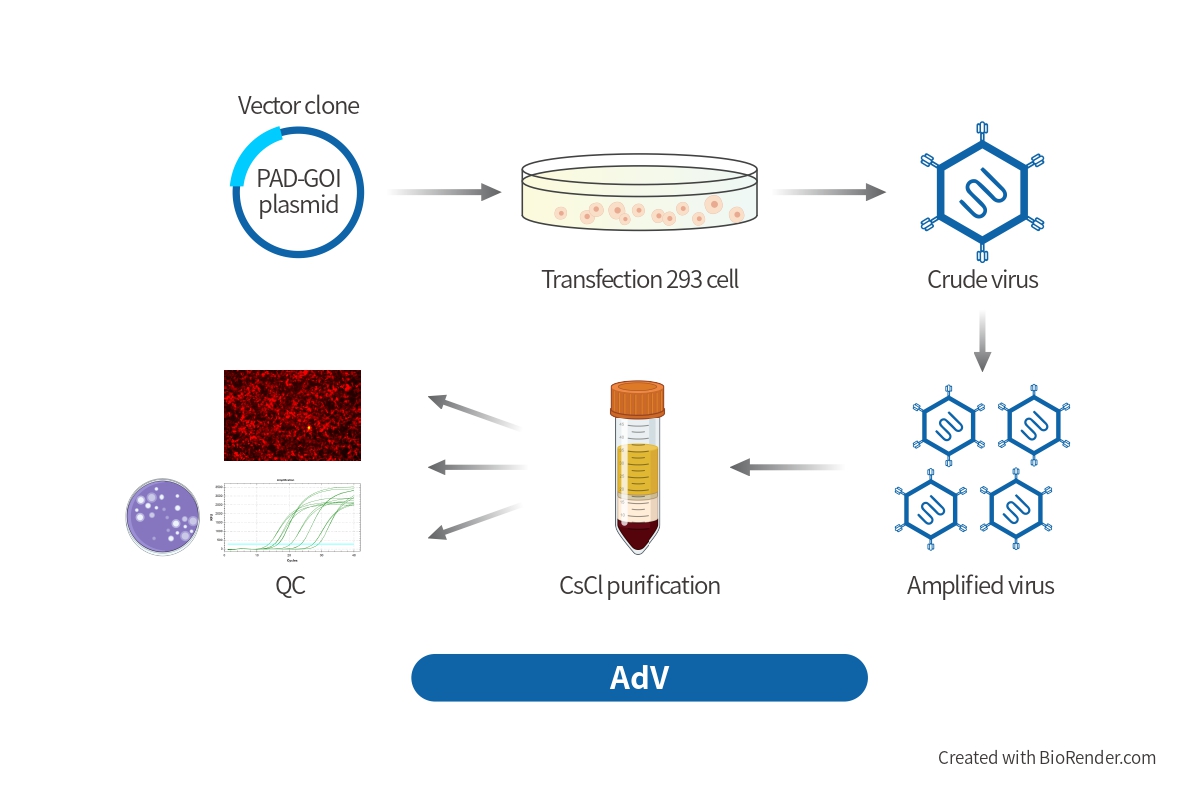Technical Workflow

Step1. How to choose a suitable vector backbone?
Each viral delivery system has different characteristics, so it is important for you to choose the right vector in your research. Below is a quick comparison for some commonly used viral delivery vectors.
| Viral Vector | AAV | LV | Ad |
|---|---|---|---|
| Genome | ssDNA | ssRNA (+) | dsDNA |
| Coat | Naked | Enveloped | Naked |
| Type | Non-integrating | Integrating | Non-integrating |
| Infection | Dividing and non-dividing cells | Dividing and non-dividing cells | Dividing and non-dividing cells |
| Packaging Capacity | 4.9kb | 6kb | 7.5kb |
| Expression | Potentially long-lasting | Long-lasting | Transient |
| Immunogenicity | Very Low | Low | High |
| Transduction Efficiency | Moderate | Moderate | High |
| Biosafety | BSL-1 | BSL-2 | BSL-2 |
Step2. How to choose the promoter
BrainVTA offers various tissue-specific promoters. Listed below are the most commonly chosen promoters. Don' see the promoter of interest, please contact us. There are many other options in our library, meanwhile, custom promoter and serotype service are avaliable.
| Organ | Serotype | Promoter |
|---|---|---|
| Nervous System | Cross BBB: AAV-PHP.eB, AAV-B10 Brain: AAV1, AAV2, AAV5, AAV8, AAV9 PNS: AAV-PHP.S, AAV9, AAV-MaCPNS1/2 Retrograde labeling: AAV2/retro, AAV11 Anterograde Trans-synaptic: AAV1 | hSyn, CaMKIlα, mecp2, c-fos, TH, GFAP, GfaABC1D, CX3CR1, Cd68, L7/pcp2, MPZ, MBP,NG2, ChAT, mDIX, PV, NPY, SST(som), VGAT1/2, VGLUT2, DBH |
| Eye | Eye: AAV2, AAV5, AAV8, AAV9 Retina: AAV5, AAV8, AAV-Anc8OL65, AAV9, AAV-2.NN Retinal Müller cells: AAV-ShH10, AAV-ShH10 (Y445F) | CAG, CAR, Grm6 |
| Heart | AAV9 | cTnT, CS-CRM4-αMHC, CMV |
| Muscles | Muscle: AAV1, AAV6, AAV7, AAV8, AAV9, MyoAAV Smooth muscle: AAV1, AAV2, AAV5, AAV9 Skeletal muscle: AAV1, AAV-Anc80L65, AAV9 | tMCK, MHCK7, CAG |
| Liver | AAV2, AAV5, AAV7, AAV8, AAV-DJ, AAV-Rh10, AAV-Anc80L65 | TBG, TTR, Efl1α |
| Lung | AAV6, AAV-6.2, AAV-6.2FF, AAV9, AAV-DJ, AAV-Rh10 | CMV, CAG |
| Kidney | AAV2, AAV8, AAV-DJ | CMV, CAG |
Step 3. Add the GOI, Tag, reporter, linker
BrainVTA have an extensive collection of commonly used element (tags, reporters, linkers,ect) and gene in neurosciences as well as human and murine genes, so it is very easily to recombine them into viral vectors. If your GOI is out of our gene pool, BrainVTA can offer gene synthesis, mutagenesis, shRNA and CRISPR-Cas9 services to customize your order. Or if you have some materials in hand, you can send it to us, we do subclone into a custom viral vector.
| Genetic Element | Available Options |
|---|---|
| Tags | 6xHis, 3XFlag, HA, Myc |
| Localization | H2B, NLS, soma, NES, LCK, mito, axon |
| Linker | 2A, IRES |
| Reporters | EGFP, mCherry, RFP, tagBFP, CFP, mCelulean, mCitrine, dsRed, Luciferase, etc |
Step 4 Package into Virus Particle
If you would like your custom vector packaged into viral particles, please specify when you request a quote. Please visit our AAV, adenovirus, and lentivirus viral vector packaging services page for more information!
AAV package service one stop









